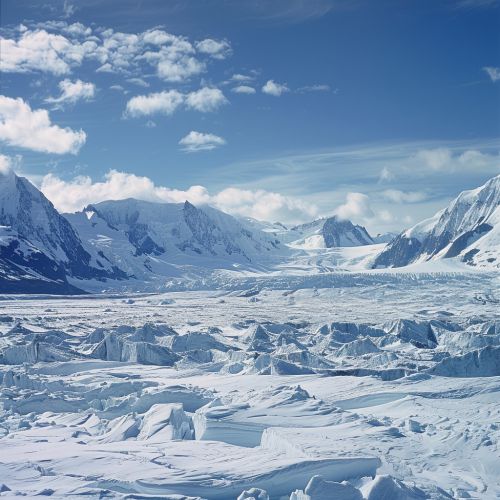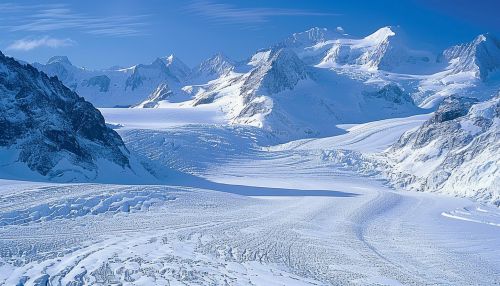Global climate system
Introduction
The global climate system is a complex and dynamic network of interconnected components that regulate the Earth's climate. This system encompasses the atmosphere, hydrosphere, cryosphere, lithosphere, and biosphere. Each of these components interacts with one another through various physical, chemical, and biological processes, influencing global weather patterns, temperature distributions, and precipitation levels. Understanding the global climate system is crucial for predicting future climate changes and mitigating their impacts.
Components of the Global Climate System
Atmosphere
The atmosphere is the layer of gases surrounding the Earth, primarily composed of nitrogen (78%), oxygen (21%), and trace amounts of other gases such as carbon dioxide, methane, and water vapor. The atmosphere plays a vital role in regulating the Earth's temperature through the greenhouse effect, where certain gases trap heat from the sun, preventing it from escaping back into space. This process maintains the Earth's average temperature at a habitable level.
Hydrosphere
The hydrosphere encompasses all water on Earth, including oceans, rivers, lakes, and groundwater. The oceans, which cover approximately 71% of the Earth's surface, are the largest component of the hydrosphere and play a critical role in regulating the global climate. Ocean currents, driven by wind, temperature, and salinity differences, redistribute heat around the planet, influencing regional climates. The hydrological cycle, which involves the continuous movement of water between the atmosphere, land, and oceans, is essential for maintaining the Earth's climate balance.
Cryosphere
The cryosphere consists of all frozen water on Earth, including ice caps, glaciers, sea ice, and permafrost. The cryosphere has a significant impact on the global climate system due to its high albedo, or reflectivity, which helps to regulate the Earth's temperature by reflecting solar radiation back into space. Changes in the cryosphere, such as melting ice caps and glaciers, can lead to rising sea levels and altered ocean circulation patterns, further influencing the global climate.


Lithosphere
The lithosphere is the Earth's outermost layer, consisting of the crust and the uppermost part of the mantle. The lithosphere interacts with the atmosphere, hydrosphere, and biosphere through processes such as volcanic eruptions, weathering, and erosion. Volcanic eruptions, for example, can release large amounts of aerosols and greenhouse gases into the atmosphere, affecting global temperatures and weather patterns. The lithosphere also plays a role in the carbon cycle, as carbon is stored in rocks and sediments over geological timescales.
Biosphere
The biosphere includes all living organisms on Earth and their interactions with the other components of the climate system. Plants, for example, absorb carbon dioxide during photosynthesis, playing a crucial role in regulating atmospheric carbon levels. The biosphere also influences the hydrological cycle through processes such as transpiration, where water is released from plants into the atmosphere. Human activities, such as deforestation and fossil fuel combustion, have significantly impacted the biosphere and, consequently, the global climate system.
Climate Forcing and Feedback Mechanisms
Climate Forcing
Climate forcing refers to external factors that can influence the Earth's climate system. These factors can be natural, such as volcanic eruptions and solar variability, or anthropogenic, such as greenhouse gas emissions and land-use changes. Climate forcing can alter the balance of incoming and outgoing energy in the Earth's climate system, leading to changes in global temperatures and weather patterns.
Feedback Mechanisms
Feedback mechanisms are processes that can either amplify or dampen the effects of climate forcing. Positive feedback mechanisms, such as the ice-albedo feedback, can enhance the initial forcing, leading to more significant climate changes. For example, as ice melts, the Earth's albedo decreases, causing more solar radiation to be absorbed and further accelerating ice melt. Negative feedback mechanisms, on the other hand, can counteract the initial forcing, stabilizing the climate system. An example of a negative feedback mechanism is the increase in cloud cover due to higher temperatures, which can reflect more solar radiation and cool the Earth's surface.
Climate Models and Predictions
Climate Models
Climate models are mathematical representations of the Earth's climate system, used to simulate and predict future climate changes. These models incorporate various physical, chemical, and biological processes that govern the interactions between the atmosphere, hydrosphere, cryosphere, lithosphere, and biosphere. Climate models can range from simple energy balance models to complex general circulation models (GCMs) that simulate the three-dimensional structure of the Earth's climate system.
Predictions
Climate models are used to project future climate changes based on different scenarios of greenhouse gas emissions and other climate forcings. These projections indicate that the Earth is likely to experience significant warming over the coming decades, with associated changes in precipitation patterns, sea level rise, and increased frequency and intensity of extreme weather events. However, there is still uncertainty in these predictions due to the complexity of the climate system and the limitations of current models.
Human Impact on the Global Climate System
Greenhouse Gas Emissions
Human activities, particularly the burning of fossil fuels and deforestation, have led to a significant increase in the concentration of greenhouse gases in the atmosphere. Carbon dioxide, methane, and nitrous oxide are the primary greenhouse gases emitted by human activities. These gases trap heat in the atmosphere, leading to global warming and associated climate changes.
Land-Use Changes
Land-use changes, such as deforestation, urbanization, and agriculture, have also impacted the global climate system. Deforestation, for example, reduces the Earth's capacity to absorb carbon dioxide, while urbanization can alter local climates through the urban heat island effect. Agricultural practices can affect the hydrological cycle and contribute to greenhouse gas emissions through activities such as livestock production and rice cultivation.
Mitigation and Adaptation
Addressing human impacts on the global climate system requires both mitigation and adaptation strategies. Mitigation efforts aim to reduce greenhouse gas emissions and enhance carbon sinks, such as reforestation and the development of renewable energy sources. Adaptation strategies focus on adjusting to the inevitable changes in the climate system, such as building resilient infrastructure, implementing sustainable agricultural practices, and developing early warning systems for extreme weather events.
